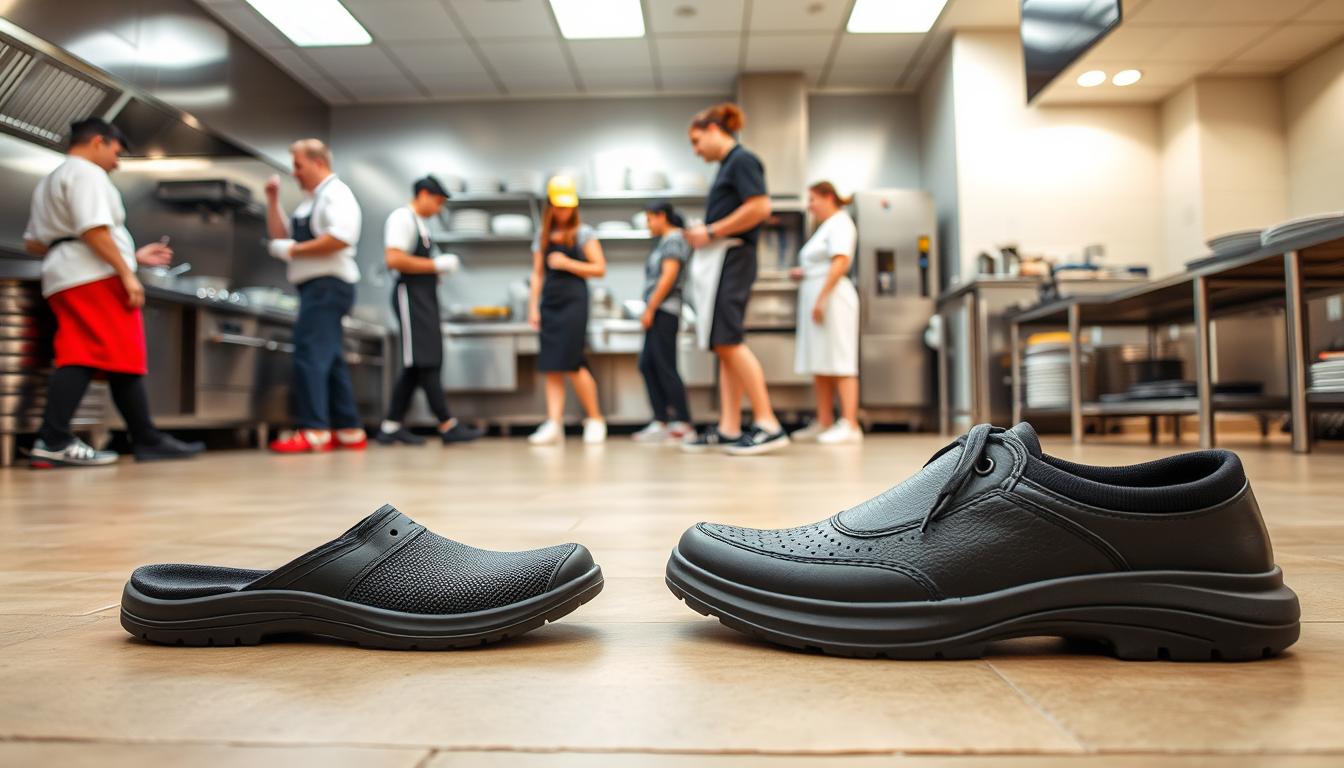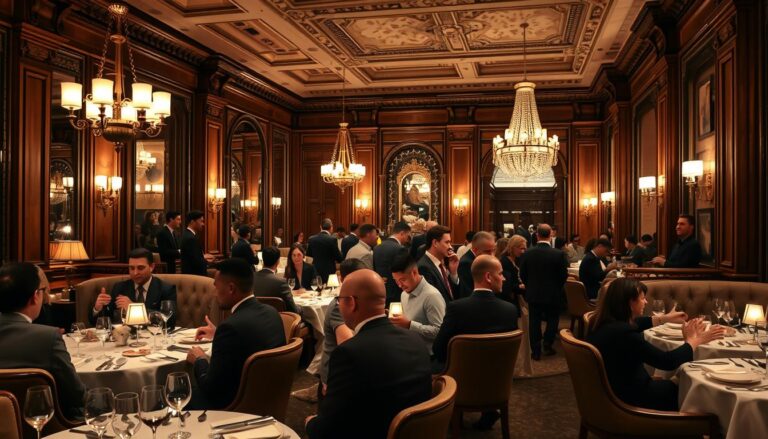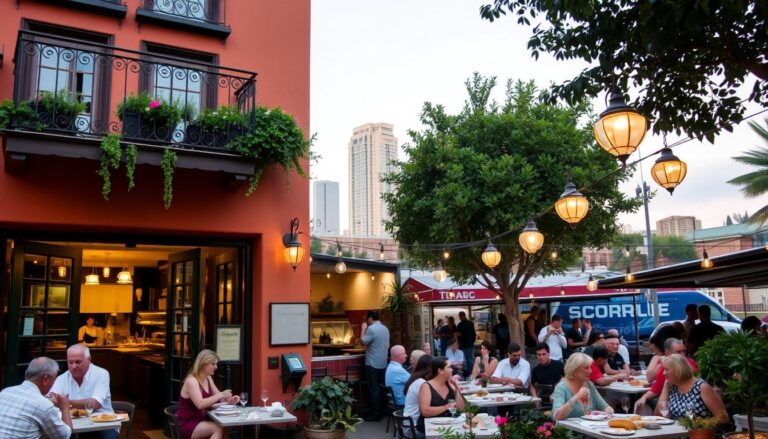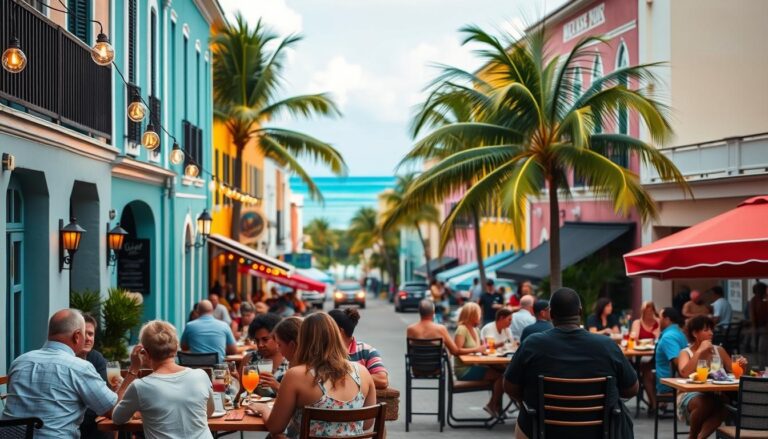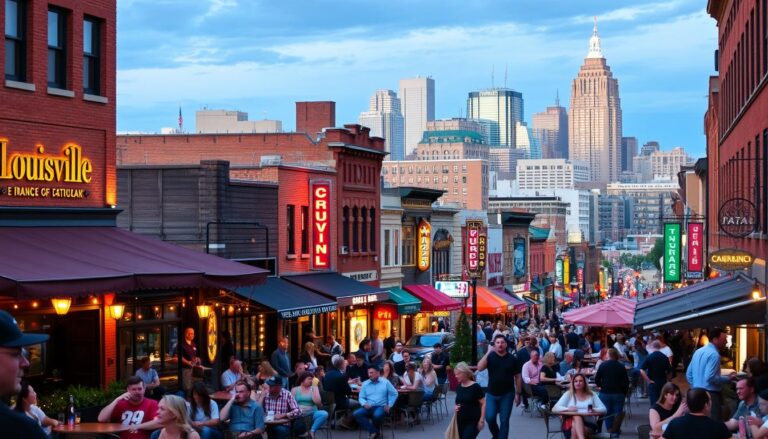Comfortable Shoes for Restaurant: Safety Staff (Essential Guide)
Restaurant workers face special challenges with their shoes. The right pair can make a tough shift easier. It helps prevent injuries and keeps staff from getting too tired.
Working in a restaurant needs shoes that are safe, comfy, and last long. Whether you’re a chef or a server, picking the right shoes is key. It helps you do your job better and stay healthy.
Restaurant staff spend a lot of time on their feet. They move fast in busy places. So, they need shoes that can handle this and keep them safe.
Choosing the right shoes is very important for restaurant workers. It affects their health, how well they do their job, and how happy they are. Today’s shoes have special features to help with these challenges.
This guide will help you find the best shoes for restaurant work. You’ll learn about safety standards, what materials are best, and get recommendations for the top shoes. These are designed for the kitchen and dining areas.
Restaurant workers need shoes that are comfortable, safe, and perform well. Good shoes can make their job easier and reduce health risks from standing and moving a lot.
Things like slip resistance, cushioning, arch support, and durability are very important. Knowing these helps workers choose the best shoes for their job.
Whether you’re a chef, server, or new to the industry, picking the right shoes is important. The next parts will give you all the details you need to choose the best shoes for your job.
Understanding Restaurant Footwear Requirements
Restaurant workers face unique challenges. Specialized footwear is key to their safety. Non-slip restaurant shoes protect them from hazards in wet, high-traffic areas.
The food service industry has strict safety standards for shoes. Slip resistant shoes are essential to prevent accidents.
Industry Safety Standards and Regulations
Workplace safety groups set rules for restaurant shoes. These rules cover important areas:
- Slip resistance on various surfaces
- Protection against spills
- Meeting safety requirements
- Durability in stressful environments
Essential Features for Restaurant Shoes
Choosing the right non-slip restaurant shoes requires looking at several key features:
| Feature | Importance | Benefit |
|---|---|---|
| Tread Pattern | High | Maximizes grip on wet surfaces |
| Cushioned Insole | Medium | Reduces foot fatigue during long shifts |
| Water-Resistant Material | High | Protects against liquid spills |
Impact of Proper Footwear on Worker Safety
Proper slip resistant shoes greatly reduce injuries. They provide stable footing and protection, preventing serious accidents.
Restaurant workers stand for hours on tough surfaces. The right shoes are a vital investment in their safety and job performance.
The Importance of Slip-Resistant Soles in Kitchen Environments
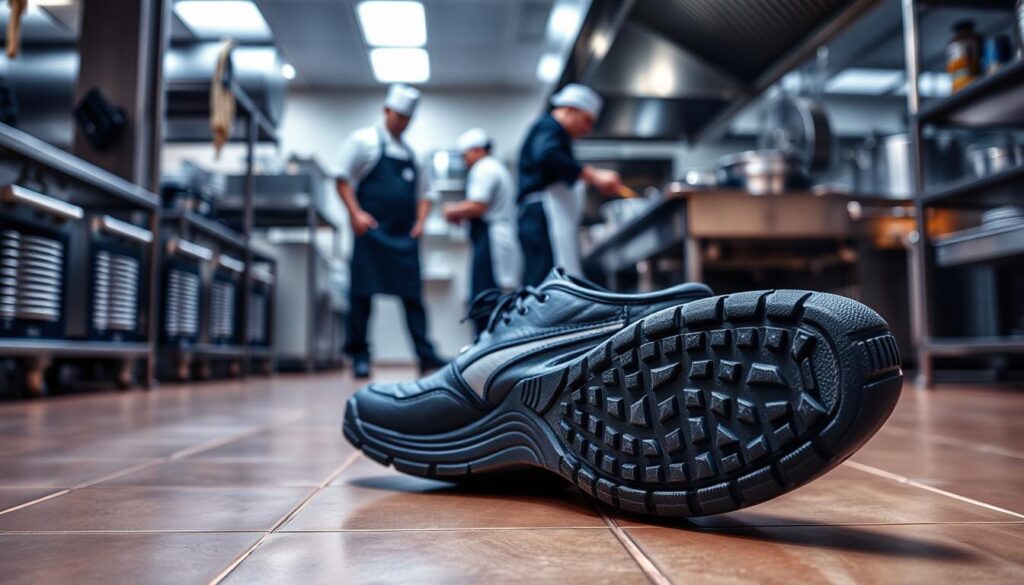
Restaurant kitchens are full of dangers, with wet and greasy floors being a big risk. Slip resistant shoes are key for kitchen workers. They help keep staff safe from accidents.
Non-slip restaurant shoes have special soles that stick to the floor well. They have unique tread patterns and rubber that grip slippery floors.
- Advanced rubber compounds with enhanced grip
- Specialized tread patterns for maximum traction
- Multi-directional channel designs
- Micro-grooves that channel liquids away from shoe surface
Kitchen environments need specific shoes to stay safe. Chefs and kitchen staff need shoes that can handle water, grease, and spills. They must stay grippy.
Choosing the right non-slip shoes is important. Look at:
- Tread depth and pattern complexity
- Material durability
- Resistance to oil and water
- Overall shoe construction
Buying good slip resistant shoes is more than safety. It’s about confidence and doing a better job. When staff feel safe, they can focus on cooking without fear of slipping.
Best Shoes for Restaurant Workers: Top Picks for 2024
Finding the right shoes is key for those who work long hours on their feet. The best shoes for restaurant workers offer comfort, safety, and durability. They help professionals get through demanding shifts.
Choosing the right pair of durable chef shoes is important. Restaurant staff need shoes that support their feet well, prevent slipping, and protect them in stressful kitchen environments.
High-End Professional Options
Professional-grade shoes are the best for serious culinary experts. Here are some top picks:
- Dansko Professional Clogs – Known for exceptional arch support
- Birkenstock Slip-Resistant Work Shoes – Premium comfort and durability
- Crocs Bistro Clogs – Lightweight and easy to clean
Budget-Friendly Alternatives
Workers on a tight budget can find quality shoes without spending a lot. Here are some affordable options:
- Skechers Work Relaxed Fit – Comfortable and affordable
- New Balance Slip-Resistant Work Shoes – Great value for money
- Dr. Scholl’s Kitchen Shoes – Budget-friendly comfort
Most Durable Selections
For long-lasting performance, these shoes are the most durable:
- Shoes for Crews Slip-Resistant Footwear
- Nike Zoom Air Restaurant Work Shoes
- Keen Utility Work Shoes
Pro tip: Always choose shoes with non-slip soles, easy-to-clean materials, and maximum comfort for restaurant work.
Material Considerations for Restaurant Footwear
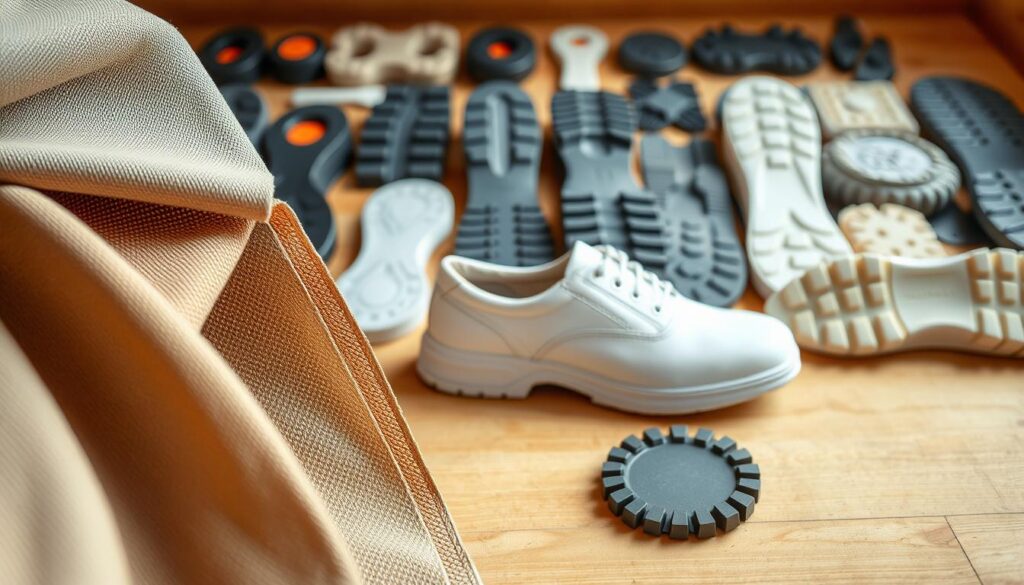
Choosing the right materials for kitchen shoes is key for restaurant workers. Durable chef shoes must handle tough work environments well. They should also be comfortable and protect the feet. Different materials bring unique benefits, making the choice important for both performance and safety.
Restaurant workers face intense conditions. The best materials for kitchen shoes have several important qualities:
- Leather: Classic choice for durability and professional look
- Synthetic materials: Lightweight and simple to clean
- Advanced fabric technologies: Better breathability and moisture control
Professional chefs look for water-resistant and stain-resistant materials. Leather is a top pick for durable chef shoes because it naturally resists liquids and lasts long. Synthetic leather offers similar protection but is easier to care for.
Modern kitchen shoes use advanced materials to tackle specific work challenges:
- Quick-drying fabrics
- Anti-microbial treatments
- Reinforced toe and heel sections
When picking kitchen shoes, think about your restaurant’s needs. Workers in hot kitchens might choose breathable synthetic materials. Those in fancy restaurants might prefer traditional leather for a sleek look.
Ergonomic Design Features for Long-Standing Comfort
Restaurant workers often stand for hours, making good shoes a must for their health and work. Ergonomic design is key in making shoes that last through long shifts.
Good shoe design is more than just being comfy. It’s about helping workers stay healthy and productive. The right shoes can cut down on tiredness and stop foot problems.
Arch Support Systems
Arch support is vital for those who stand a lot. Different feet need different kinds of support:
- High arch support for those with elevated foot arches
- Neutral support for standard foot structures
- Enhanced cushioning for flat-footed individuals
Cushioning Technologies
Today’s food service shoes have new cushioning tech for extra comfort:
- Memory foam insoles that fit your foot shape
- Gel-based padding for shock absorption
- Air-cushion systems that lessen impact
Weight Distribution Features
Features that spread weight evenly help avoid tiredness and leg strain. New shoes have:
- Contoured footbeds for even pressure
- Reinforced heel and toe for stability
- Light materials to prevent foot tiredness
Buying high-quality, ergonomic shoes is more than just about feeling good. It’s about supporting the hard work of those who keep restaurants going.
Kitchen-Specific Shoe Requirements for Chefs
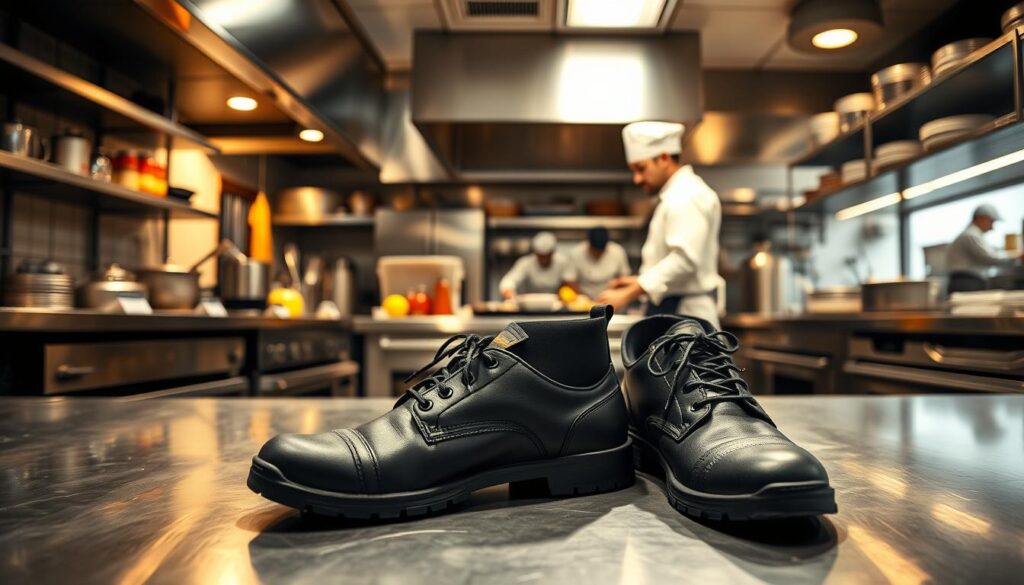
Professional chefs know how important the right shoes are in their work. Durable chef shoes are more than just a fashion choice. They are a key safety item in busy kitchens.
When picking shoes for the kitchen, there are a few things to think about:
- Heat resistance for near-stove environments
- Slip-resistant outsoles
- Protective toe coverage
- Liquid and oil repellent materials
- Lightweight design for extended standing
Professional chef shoes have special features for kitchen challenges. Breathable materials keep feet cool and dry. Reinforced parts protect against accidents. Chefs need shoes that are safe, comfy, and look good.
Kitchen shoes must do several things:
- Protect against hot liquid spills
- Provide stable traction on wet surfaces
- Offer comfort during long shifts
- Resist punctures and sharp object impacts
Top chefs choose high-quality shoes that meet strict safety rules. The right shoes keep workers safe and help them perform better in fast kitchens.
Front-of-House Staff Footwear Solutions
Restaurant front-of-house staff have special needs when picking shoes. They need shoes that look good and feel great for long hours.
Staff in the front-of-house need shoes that are stylish, functional, and last long. The right shoes can really help a server do their job better and feel good at work.
Style and Professionalism
Choosing the right server shoes involves a few important things:
- Matching the restaurant’s dress code
- Looking polished and professional
- Feeling comfortable for long hours
Comfort for Extended Service Hours
Servers are on their feet and walking a lot. Ergonomic design is key in picking shoes that support their feet well.
| Shoe Feature | Importance for Servers |
|---|---|
| Non-slip Soles | Helps prevent slips on wet or slippery floors |
| Arch Support | Lessens foot pain during long hours |
| Breathable Materials | Keeps feet cool in hot places |
Buying good server shoes is more than looks. It’s about keeping your staff comfortable and doing well.
Water-Resistant and Easy-Clean Properties
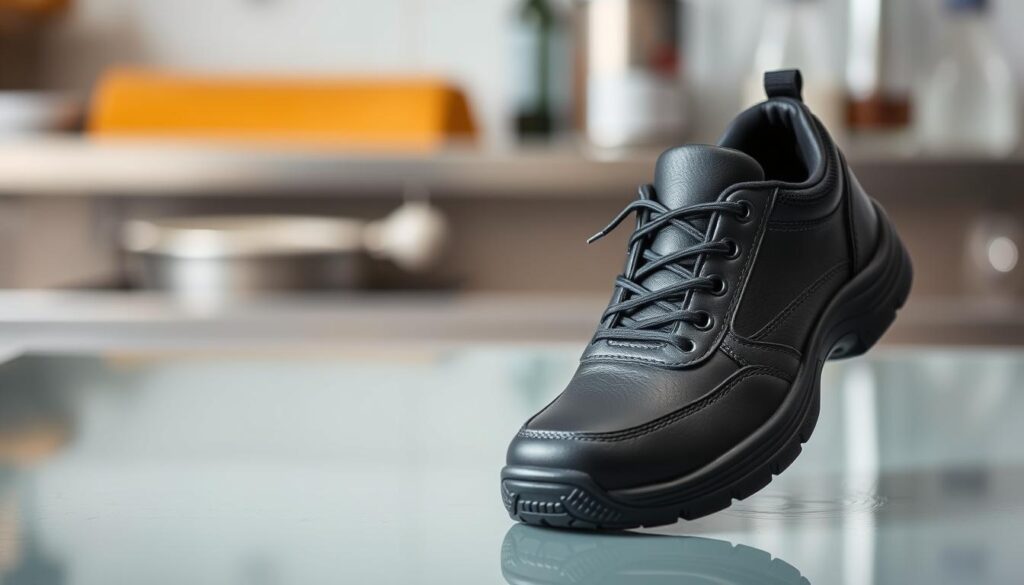
People working in the food service industry know how important it is to have shoes that can handle water and are easy to clean. Spills and moisture are always a problem in restaurants. That’s why special shoes are needed to keep the workplace safe and clean.
The top kitchen shoes have special protection against water. They use new technologies to keep workers dry from:
- Hot liquid spills
- Grease splatters
- Cleaning solution exposure
- General kitchen moisture
When picking out water-resistant shoes, look for these important features:
| Feature | Benefits | Recommended Materials |
|---|---|---|
| Waterproof Coating | Prevents liquid absorption | Synthetic leather, Treated canvas |
| Sealed Seams | Blocks moisture entry points | Rubberized edges, Welded construction |
| Quick-Dry Lining | Reduces bacterial growth | Microfiber, Moisture-wicking fabrics |
Good kitchen shoes should be easily sanitizable. They should have smooth surfaces that can be quickly cleaned and won’t stain easily. Shoes with removable insoles and designs that can be washed in a machine make cleaning up easier. This helps keep food service areas clean and safe.
Price Range Analysis and Value Considerations
Choosing the right shoes for restaurant staff is key. It’s about finding a balance between price, durability, and how well they perform. Workers need shoes that can handle tough kitchen and service environments. They also need to protect their feet and support them during long hours of standing.
Looking for the best shoes for restaurant workers, you’ll find three main price ranges:
- Budget Options ($30-$60): Basic protection with limited durability
- Mid-Range Selections ($60-$120): Improved comfort and longer-lasting materials
- Professional-Grade Shoes ($120-$250): Premium features with maximum workplace performance
Investment vs. Durability
Quality restaurant work shoes are a vital investment. They ensure safety and comfort at work. While cheaper shoes might seem like a good deal at first, they can end up costing more in the long run. This is due to frequent replacements and possible foot health problems.
Replacement Frequency Guidelines
Restaurant workers should replace their shoes based on certain signs:
- Visible sole wear or reduced slip resistance
- Decreased cushioning and support
- Evidence of material breakdown
- Approximately every 6-12 months of regular use
Choosing the right shoes helps workers keep their feet safe while staying within their budget.
Breaking in New Restaurant Shoes: Tips and Techniques
Getting new food service shoes to fit right can be tough for those who are on their feet all day. The right steps can turn stiff, uncomfortable shoes into ones that support you all shift long.
Begin the break-in slowly to avoid blisters and discomfort. Here are some effective ways to make your new shoes more comfy:
- Wear thick socks at first to protect your feet
- Use leather softening spray for quick conditioning
- Stretch tight spots with a professional shoe stretcher
- Walk around your home to gradually mold the shoes to your feet
When picking out food service shoes, keep these break-in tips in mind:
- Start with short wearing periods – Begin with 30-minute intervals
- Use moleskin or blister prevention patches on areas prone to friction
- Apply leather conditioner to soften the material
- Alternate between new and old shoes during the transition
Professional chefs and servers know that comfy shoes are key to their daily success. Being patient during the break-in ensures your shoes will be a reliable partner through long, tough shifts.
Maintaining and Cleaning Professional Kitchen Footwear
Keeping durable chef shoes in good shape is key for those who work long hours on their feet. Kitchen footwear needs special care to last long, perform well, and stay clean in tough culinary settings.
Workers in professional kitchens spend a lot on good shoes. So, regular care is vital to protect their investment. The right care can make your shoes last longer and keep them safe.
Daily Care Routines
- Wipe down durable chef shoes right after each shift
- Remove extra grease and food bits with a damp cloth
- Let kitchen footwear air dry at room temperature
- Use special cleaning products for work shoes
- Don’t dry shoes near direct heat
Extended Lifespan Strategies
Restaurant pros can make their kitchen footwear last longer with smart maintenance:
- Switch between two pairs of shoes to dry fully between uses
- Keep shoes in a cool, dry spot, away from sunlight
- Change insoles every 3-6 months for best comfort and support
- Apply protective sprays to fight water and stains
- Get professional cleaning or restoration every 6-12 months
By following these care tips, restaurant workers can keep their durable chef shoes comfy, safe, and looking professional all day.
Health Benefits of Proper Restaurant Work Shoes
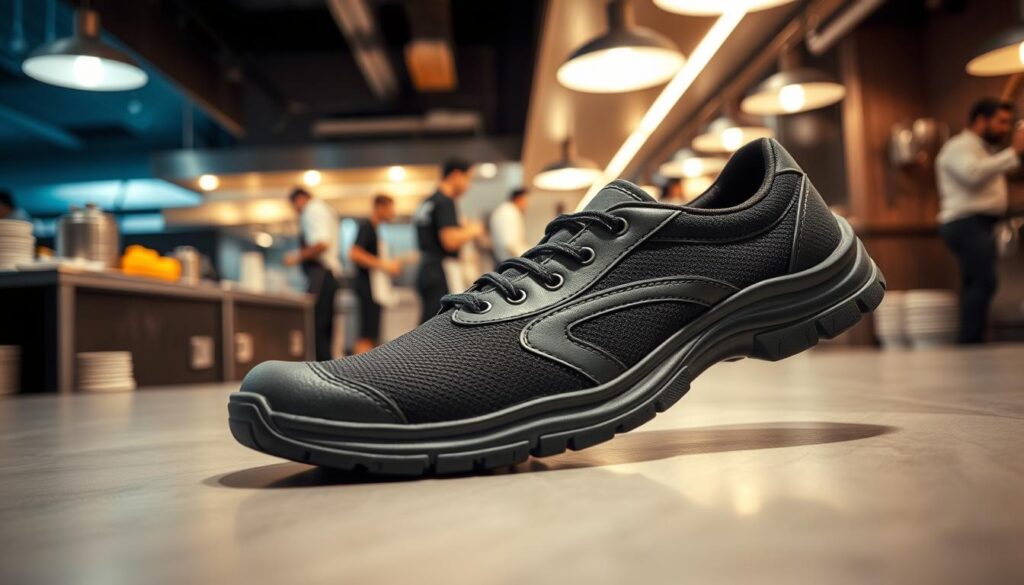
Restaurant workers often stand for long hours on hard floors. This makes wearing the right shoes very important. It helps keep them healthy and prevents injuries at work. The right shoes are more than just protection; they’re an investment in health and work performance.
Proper shoes for restaurant workers offer many health benefits:
- Less chance of chronic foot pain and musculoskeletal disorders
- Better posture and spinal alignment
- Lower risk of work-related injuries
- Better blood flow during long shifts
Professional podiatrists say the right shoes can greatly reduce health risks. Ergonomic design features like arch support and shock absorption are key. They help prevent issues like plantar fasciitis, knee strain, and lower back pain.
| Health Concern | Impact of Proper Footwear | Prevention Strategy |
|---|---|---|
| Foot Fatigue | Reduces muscle strain | Cushioned insoles |
| Lower Back Pain | Supports natural spine alignment | Orthopedic shoe design |
| Joint Stress | Minimizes impact on knees | Shock-absorbing materials |
Buying high-quality, comfortable work shoes is more than just a quick fix. It’s a long-term health plan for those who are on their feet for hours.
Common Footwear Mistakes to Avoid in Food Service
Restaurant workers face many challenges when picking the right shoes. The right shoes can keep them safe and prevent injuries. Many staff members make mistakes that affect their comfort and safety.
It’s important to know the common mistakes in choosing non-slip restaurant shoes. This knowledge helps keep the workplace safe and protects personal well-being. Many focus too much on style and not enough on function, which is risky in busy kitchens.
- Wearing shoes without proper slip resistance
- Selecting footwear based solely on appearance
- Neglecting regular shoe maintenance
- Ignoring individual comfort requirements
- Failing to replace worn-out work shoes
Experienced restaurant managers say it’s key to focus on safety first. Safety should always supersede fashion when selecting professional kitchen footwear.
| Mistake | Potential Consequences | Recommended Solution |
|---|---|---|
| Non-slip shoe negligence | High injury risk | Choose certified non-slip restaurant shoes |
| Inadequate arch support | Foot and back pain | Select shoes with ergonomic design |
| Worn-out footwear | Reduced traction | Replace shoes every 6-12 months |
Quality food service shoes are key to protecting employee health and safety. Restaurant workers should look for shoes that are comfortable, durable, and meet professional standards.
Seasonal Considerations for Restaurant Shoes
Choosing the right shoes for restaurant staff is key all year round. Each season brings its own set of challenges for those working in food service. Knowing these differences helps workers pick the best slip resistant shoes for their job.
In winter, safety in footwear is a must. Wet and slippery floors are common, raising the risk of accidents. Restaurant staff need shoes that grip well and keep feet warm and dry.
- Winter shoe requirements:
- Waterproof exterior
- Enhanced grip soles
- Thermal insulation
- Summer shoe considerations:
- Breathable materials
- Lightweight design
- Moisture-wicking properties
Summer brings its own set of challenges for restaurant staff footwear. The heat and sweat require shoes that breathe and dry fast. Workers need shoes that are comfortable and safe for long hours.
| Season | Key Shoe Features | Safety Considerations |
|---|---|---|
| Winter | Thick soles, insulated | Maximum slip resistance |
| Summer | Lightweight, ventilated | Sweat absorption, grip |
| Transitional | Adaptable materials | Versatile traction |
Restaurant managers should invest in shoes that can handle different seasons. Prioritizing employee safety and comfort across seasons ensures optimal workplace performance.
Conclusion
Choosing the right shoes is key for restaurant workers. They need comfort and safety in their tough jobs. The best shoes are more than just fashion—they’re an investment in health and work performance.
From kitchen staff to servers, the right shoes can cut down on fatigue and injury risks. Comfortable work shoes are a must in the fast-paced food service world. They should have slip-resistant soles, good arch support, and last long.
Brands like Dansko, Crocs Professional, and New Balance make shoes for restaurant jobs. These shoes are made to handle the challenges of the work environment.
Restaurant workers should see good shoes as a key tool for their job. The right shoes can improve comfort, safety, and job performance. They help manage long shifts, prevent injuries, and keep up professional standards.
In the end, picking the right shoes is about knowing what you need, the job demands, and what feels comfortable. Restaurant workers who choose wisely will be happier and healthier at work.
